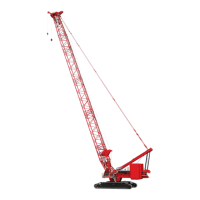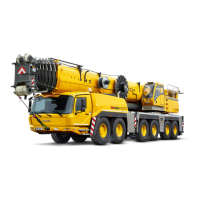Manitowoc Published 09-09-16, Control # 229-09 8-19
MLC650 SERVICE/MAINTENANCE MANUAL UNDERCARRIAGE
CRAWLER/CARBODY PIN PULLERS
CONTROL
See Figure 8-5 for the location of the following components:
• Carbody/crawler pin pullers
• Carbody manual control manifold
See Figure 8-6
for details on the carbody manual control
manifold.
See Figure 8-11
for a hydraulic schematic detail of all of the
pin puller circuits when in neutral.
See Figure 8-12
for a hydraulic schematic detail of a single
pin puller circuit when using the setup remote control.
See Figure 8-13
for a hydraulic schematic detail of a single
pin puller circuit when using the carbody manual control.
Control of the pin puller cylinders can be performed by one of
the following methods:
• Setup remote control
• Carbody manual control manifold
Carbody Manual Control
The crawler/carbody pin pullers can be manually controlled
using the hydraulic power unit (HPU) and the carbody
manual control manifold located on the front of the carbody
(see Figure 8-5
). From this location, the pin puller cylinders
can be controlled individually.
NOTE: For instructions on operating and connecting the
HPU, refer to the folio F2283—MLC650 Hydraulic
Power Unit Operation and Maintenance Manual.
Extend Pin Pullers Using Manual Control
See Figure 8-13 for the following.
When the hydraulic power unit (HPU) is connected, the
selector solenoid valve (1) is de-energized, causing the
valve to shift to the default position. When in the default
position, the selector valve routes the flow to the carbody
manual control manifold (3).
When a valve handle for a pin puller extend function is
pulled, hydraulic fluid is routed to the corresponding port on
the six-section lower accessory valve assembly (2). Inside
the valve assembly, hydraulic fluid flows through a shuttle
valve, then to the corresponding valve spool. This causes
the spool to move to a position that allows hydraulic fluid
from the accessory pump to flow to the piston end of the pin
puller cylinders. At the same time, hydraulic fluid in the rod
end of the cylinder is forced out and back to the tank. This
causes the rod to extend, engaging the pins.
Retract Pin Pullers Using Manual Control
See Figure 8-13 for the following.
When the HPU is connected, the selector solenoid valve (1)
is de-energized, causing the valve to shift to the default
position. When in the default position, the selector valve
routes the flow to the carbody manual control manifold (3).
When a valve handle for a pin puller retract function is pulled,
hydraulic fluid is routed to the corresponding port on the six-
section lower accessory valve assembly (2). Inside the valve
assembly, hydraulic fluid flows through a shuttle valve, then
to the corresponding valve spool. This causes the spool to
move to a position that allows hydraulic fluid from the
accessory pump to flow to the rod end of the pin puller
cylinders. At the same time, hydraulic fluid in the piston end
of the cylinder is forced out and back to the tank. This causes
the rod to retract, disengaging the pins.
Setup Remote Control
Setup Remote Overview
NOTE: The setup remote is covered in section 4 of the
Operator Manual.
See Figure 8-11
and Figure 8-14 for the following.
The setup remote control communicates with the CCM-10
control module using the controller area network bus (CAN
Bus). The crane control modules use the CAN Bus to
communicate with each other.
When the crane control system is on, it overrides the
carbody manual control manifold (3) for controlling
movement of the crawler/carbody pin puller cylinders. It does
this by sending a command to the CCM-10 control module.
The CCM-10 control module then sends a signal to the
CCMB11 control module to energize the selector solenoid
valve (1). The energized solenoid causes the selector valve
to shift position, stopping flow to the carbody manual control
manifold. It then routes the flow to the six-section lower
accessory valve assembly (2).
When an engage or disengage pins command is initiated on
the setup remote transmitter, the transmitter sends the
command to the setup remote receiver, which sends a signal
to the CCM-10 control module. The CCM-10 control module
then sends a signal to the CCMB11 control module to
energize the corresponding pin puller solenoids in the six-
section lower accessory valve assembly.

